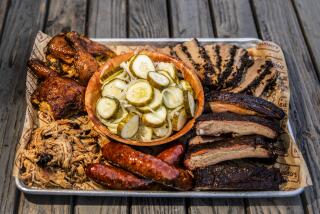It’s not so much a diet as it is a food ‘portfolio’
- Share via
The basics of lowering cholesterol -- losing weight, exercising and cutting down on “bad” fats -- haven’t changed over the years, but other cholesterol-lowering advice has evolved considerably.
That’s good news for the estimated 100 million Americans who have high blood cholesterol, which has been linked to heart disease, the country’s No. 1 killer. Diet often is the first defense before a doctor turns to drugs to lower cholesterol levels.
“Nothing has to be totally eliminated,” says dietitian David Grotto, a spokesman for the American Dietetic Assn. who frequently counsels clients who have elevated cholesterol levels.
He says “everything can be negotiated” by keeping sight of portions and making simple trade-offs. “We can find ways to still include your favorite foods.”
For starters, there may be no need to give up sunny side up breakfasts. Eggs -- the icon of cholesterol in food -- were once thought to be a major contributor to heart disease. Now it appears that the cholesterol we eat is not the greatest influence on the cholesterol in our blood.
That honor goes to saturated and trans fats.
Recent studies have shown that eating up to one egg a day didn’t raise cholesterol levels or increase the risk of heart disease in healthy people. If you already have elevated cholesterol levels, three to four eggs per week are generally allowed, Grotto says.
Eggs may be high in dietary cholesterol, but they don’t contain much saturated fat. That also is true for cholesterol-laden shrimp and other shellfish, which typically are OK in moderation as long as they’re not soaked in butter or deep-fried.
Nowadays, eating to lower cholesterol is as much about adding certain foods as it is about limiting others, says dietitian Elaine Trujillo, co-author of “Eating for Lower Cholesterol.”
A recent study published in the American Journal of Clinical Nutrition found that adding a specific combination of heart-healthy foods brought down cholesterol levels as much as first-generation statin drugs. The goal was to see if a “portfolio” of foods -- each with its own minor cholesterol-lowering benefit -- could have a larger effect when eaten together. It was the first study to examine the potential benefits of bundling four types of foods with an FDA-authorized health claim related to heart disease, according to lead author David Jenkins of the University of Toronto.
Participants ate a diet that was low in saturated fats but rich in viscous fiber (found in oats and barley), soy protein, almonds and plant sterol-fortified margarine.
After 12 months, those who strictly followed the “portfolio eating plan” lowered their LDL, or “bad” cholesterol, by 20% or more -- comparable to the levels achieved by medication. Even participants who frequently “fell off the wagon” achieved at least a 10% reduction in LDL cholesterol.
Jenkins said there was a powerful “additive effect” by combining these foods because they each work to lower cholesterol in the body in different ways.
*
(BEGIN TEXT OF INFOBOX)
Foods that can help keep cholesterol in check
Four categories of cholesterol-lowering foods helped lower “bad” cholesterol by 20% or more as part of a diet low in saturated fat, according to a recent report in the American Journal of Clinical Nutrition.
* VISCOUS FIBER: This “sticky” type of soluble fiber found in oats, barley, beans and certain vegetables such as okra and eggplant helps bind the cholesterol in your digestive tract and sweep it out of your body.
Why you need it: Eating 1 1/2 cups of cooked oatmeal a day typically produces cholesterol-lowering results. Including 10 grams of viscous fiber a day has been shown to decrease LDL cholesterol by about 5%.
How to do it: Start your day with oatmeal or a psylliumenriched cereal. Try bean- and barley-based soups, marinated bean salad, hummus sandwiches, black bean burritos and roasted eggplant.
* SOY PROTEIN: Heart-healthy alternatives to higher-fat meats. With little or no saturated fat, they provide protein, fiber, “good” fats, vitamins and minerals.
Why you need it: Recent studies have questioned soy protein’s ability to lower blood cholesterol -- suggesting it has little or no effect on the risk factors for heart disease. The primary benefit may be eating fattier fare less often.
How to do it: Go meatless at least once a week -- opting instead for soy-based products such as soy sausages, burgers, franks, cold cuts and chicken patties. Snack on soy nuts and edamame, which are fresh soybeans.
* PLANT STEROLS: Compounds -- typically extracted from soybeans or certain vegetables -- so similar in structure to cholesterol that they “compete” in our intestines. That means less of the real cholesterol is absorbed.
Why you need it: Eating 2 grams of plant sterols each day can lower LDL cholesterol by about 10%. But you need to consume them every day for the cholesterol-controlling benefit to continue.
How to do it: Look for sterol-fortified products, including margarine-type spreads (Benecol, Take Control and Smart Balance) and some brands of orange juice, yogurt, cheese, salad dressings, granola bars and chocolate.
* NUTS: The handful of almonds study participants ate each day provided cholesterollowering monounsaturated fat, plant sterols, fiber and vitamin E, an antioxidant.
Why you need it: Studies have shown that people who ate about a handful of almonds a day (or 1 ounce) lowered LDL cholesterol by 4%; those who ate two handfuls lowered it by 9%.
How to do it: Eat a variety of nuts, including walnuts, which pack in the most omega-3 fatty acids. Snack on nuts instead of pretzels or chips; toss chopped nuts into your oatmeal, salads and stir-fries.
-- Janet Helm
More to Read
Eat your way across L.A.
Get our weekly Tasting Notes newsletter for reviews, news and more.
You may occasionally receive promotional content from the Los Angeles Times.









